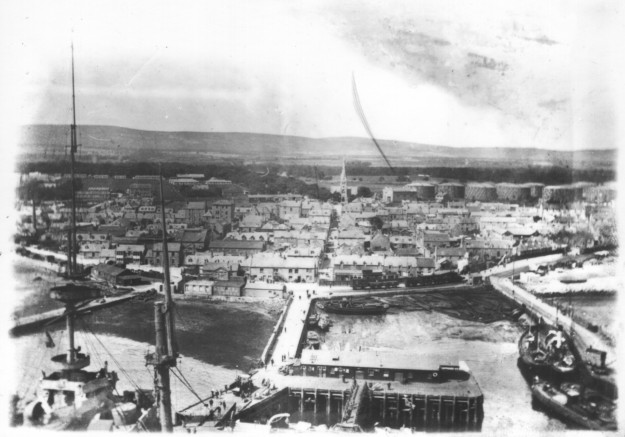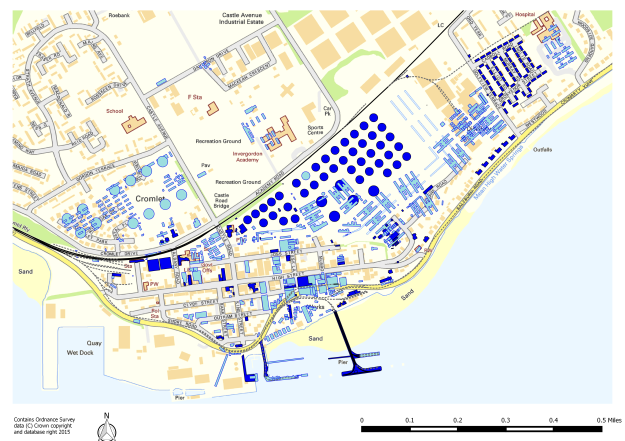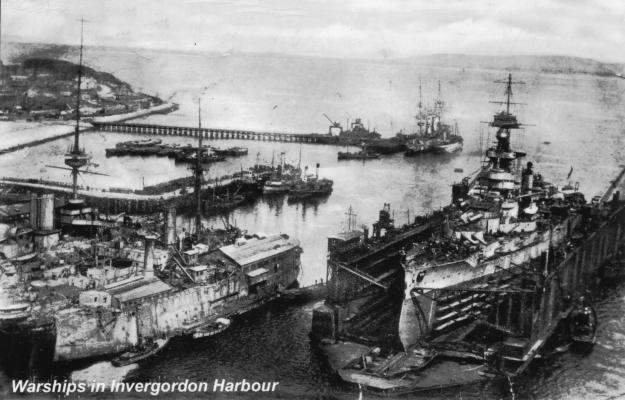by Susan Kruse (ARCH)
Over summer 2015 a large group has been meeting to explore World War I Invergordon in a project led by ARCH and funded by the Heritage Lottery Fund First World War Then and Now programme. A huge amount of information has been gathered, from contemporary military maps, old photographs, including an album compiled by someone who worked at the dockyard, aerial photos (one from WWI), and investigation of remains on the ground. The various strands of evidence have been brought together into a GIS database by Malcolm Standring, which currently has over 600 recorded structures. From this work a detailed picture of wartime Invergordon is emerging.
Many of the buildings used in World War I survive. Others are known from plans and old photos. Detailed naval plans survive showing which buildings were built or taken over – many labelled with their new use. Aerial photos also provide valuable information, including the 1930s photos (available on the Britain from Above website and the National Collection of Aerial Photographs website), showing those which were not pulled down after the war. A surprisingly valuable source of information has also been the Valuation Rolls, which detail buildings taken over or built by the military.
The group has found the GIS work invaluable, helping us in particular to locate and document structures such as the army camp which were only there during the war and have left no footprints on the ground.
Invergordon was founded in the second half of the 1700s as an estate village for Sir John Gordon. In the 1800s the harbour was developed by the MacLeods of Cadboll. The fleet came for the first time in 1863, and spurred further expansion of the harbour. The detailed 1904 2nd edition OS map shows a thriving town, with a ferry slip, two piers, railway lines going north as well as a branch line leading into the bone mill where animal carcasses were rendered into fertiliser.
As the Navy increasingly used the harbour, oil tanks were built, 10 just before the war and a further 31 during World War I. With its good harbour and rail connections Invergordon had ideal facilities to become a major naval port. Around the beginning of the war another long pier – the Admiralty pier – was constructed, with rail lines laid down to the end, enabling oil to be pumped to the tanks.

Invergordon from crow’s nest. Photo courtesy Invergordon Museum. Note railway in foreground running along the shore.
Socially and physically Invergordon was transformed by the war. While generally remembered as a naval town, there was also an army camp holding at least 2000 men (Cameron Highlanders 3rd Reserve Battalion) to the north above Cromlet Drive, providing training for soldiers. Over 4,000 dockyard workers fixed the naval ships which used the port – most ships had a 10 day turnaround. Estimates suggest the population swelled from around 1100 before the war to around 20,000. Russian migrants came through the town, soldiers and civilians. Then towards the end of the war Americans were in the area, based at Dalmore (after the whisky was relocated) where they assembled mines and transported them on a newly constructed railway line from Dalmore to the Admiralty pier, along the shore (generally on the route where the current road is now).

Invergordon West End. Photo courtesy Alan Kinghorn. This photograph shows the extent of the sprawling army camp to the north of Invergordon.
Many of the buildings in Invergordon were taken over by the military, as offices, stores or large workshops, and even the bakery and post office. But many other new buildings were constructed, including accommodation for dockyard workers and army personnel, workshops, two hospitals, three police stations for the London police securing the dockyard, generating plants to cope with energy demands, two YMCAs (one for Americans) and a YWCA, churches and entertainment venues such as cinemas and theatres. The original shoreline was roughly along the route of the current bypass road, and much of the area near the shore was reclaimed.

Plan by Malcolm Standring. Dark blue structures survive, light blue are gone. Note the extensive railways and sidings.

Officer’s House. Photo: Carolyn Samsin. The 6 officer’s houses and 126 dockyard workers’ houses for married personnel still survive.
Such a massive expansion required other works, including numerous railway sidings throughout the town, paved roads and pavements, sewage works, pipelines for the oil, and a network of power lines. Two floating docks were installed to allow ships to be repaired and fitted, with railway lines on the piers linking the large workshops on shore.
Defences were built on the Sutors, the hills where the Cromarty Firth joins the Moray Firth, and a boon was erected across the Cromarty Firth. Other defences surely guarded the town, though none survive.
The social changes in Invergordon were also great. Women were working in the town – not just as clerks, cooks and cleaners, but also as builders (they helped build the second hospital), machinists and in the the generating station. There was friction in the town as military personnel played football on the Sabbath. But by and large the town welcomed and adapted to the military.
After the war the fortunes of Invergordon declined. Most of the huts and fittings were sold. In the 1920s the popular venues of La Scala cinema (which held 600) and the Empire Theatre burnt down, some think for insurance claims because they were no longer profitable. But the fleet still visited after the war, and in the 1930s more oil tanks were built. The town again expanded during WWII, but on a smaller scale, with the navy refuelling ships and the RAF supporting seaplanes.
Find out More!
A trail leaflet of World War I Invergordon has been prepared by the group, and will be launched at an open day on Saturday, 17th October 2015 at Invergordon Museum. There will be a display from 10-1:30, leaflet launch (at 10:30), and walk around Invergordon looking at some of the sites (2-4pm). Free and all welcome.
Further information:
Pratt, Edwin A. 1921. British Railways and the Great War. Organiasation, efforts, difficulties and achievements. Available on-line at https://archive.org/details/cu31924092566128
Park School 1994. Invergordon: the Great War 1914-1918. Results from a primary school project investigating World War I – an exemplary project showing what primary children can accomplish. Copies are available in the Highland library system, or for sale at Invergordon Museum.
Ash, Marinell 1991. This Noble Harbour. A History of the Cromarty Firth.
The Invergordon Archive has a number of old photos on its image archive dating to this period. Invergordon Museum also has photographs and archives relating to WWI. Binders created by the group will be deposited at the museum and Invergordon Library, and detailed information about individual sites will be submitted to the Highland HER (her.highland.gov.uk) and Canmore (canmore.org.uk).




This where Nanna spent her first months with Charles, FL Snr and Ede
LikeLike
I’ve got some photos of a zeppelin over Invergordon as well as railcarriages loaded with mines out on the pier if someone is interested. Give me a shout here!
LikeLike
My Grandad William Reginald Stallard worked Invergordon dock yard in the first world war He was sent to Invergordon from Portsmouth dock yard His trade was a boilermaker When he left Invergordon to go home to Portsmouth his work mates presented him with a pocket watch I would like to see any old photos from that time and any records that may be around in the archives Thank you
LikeLike